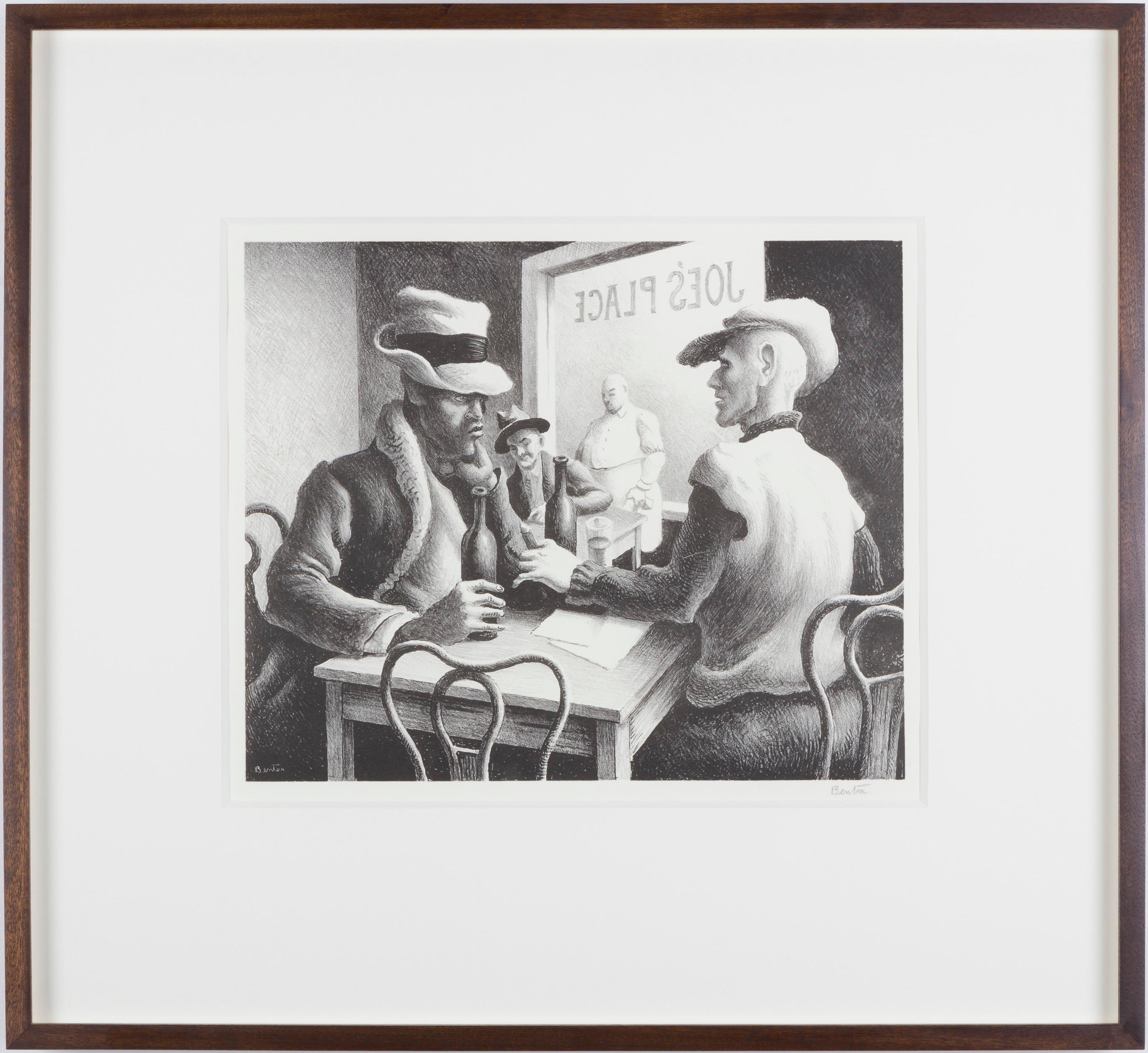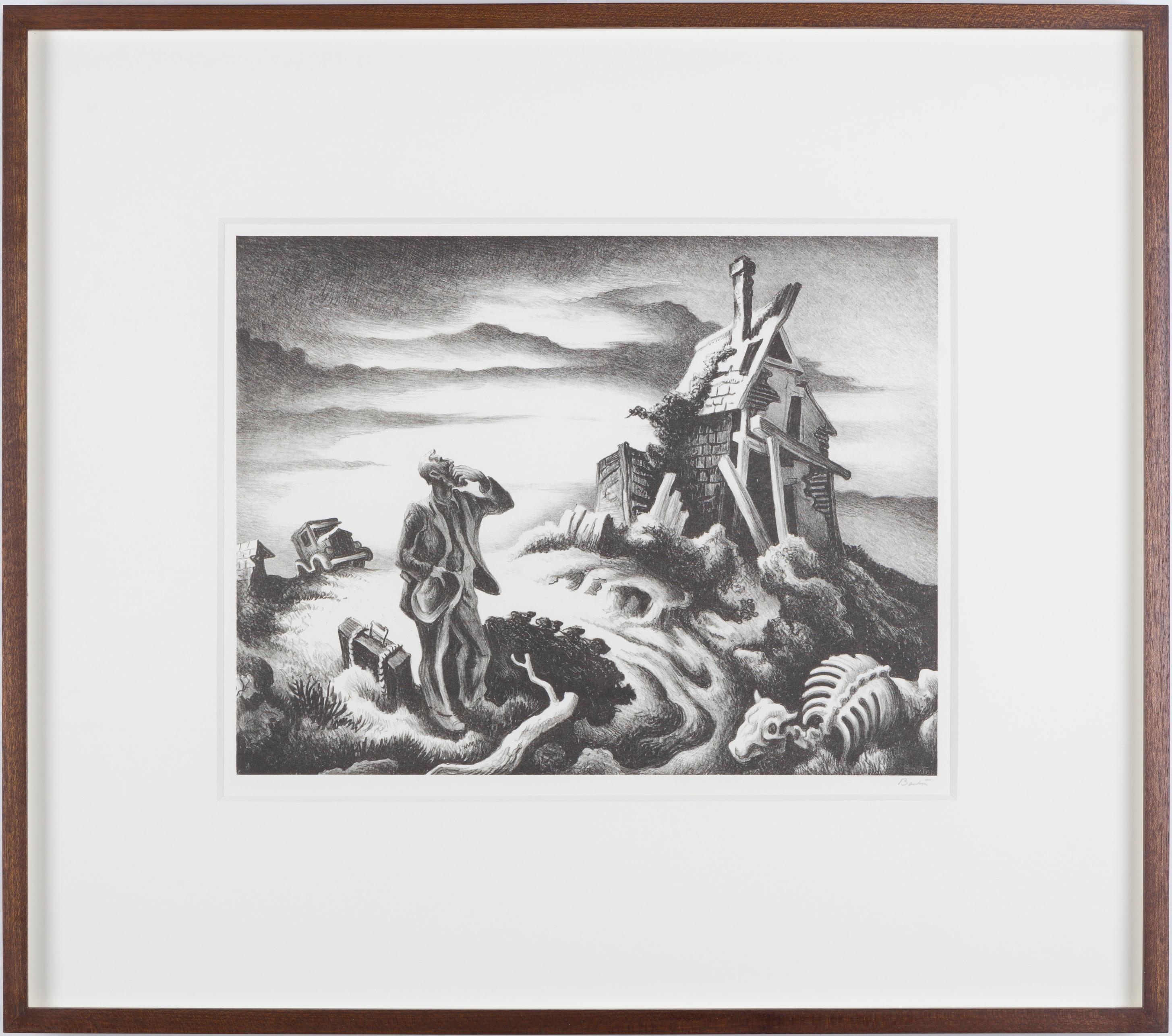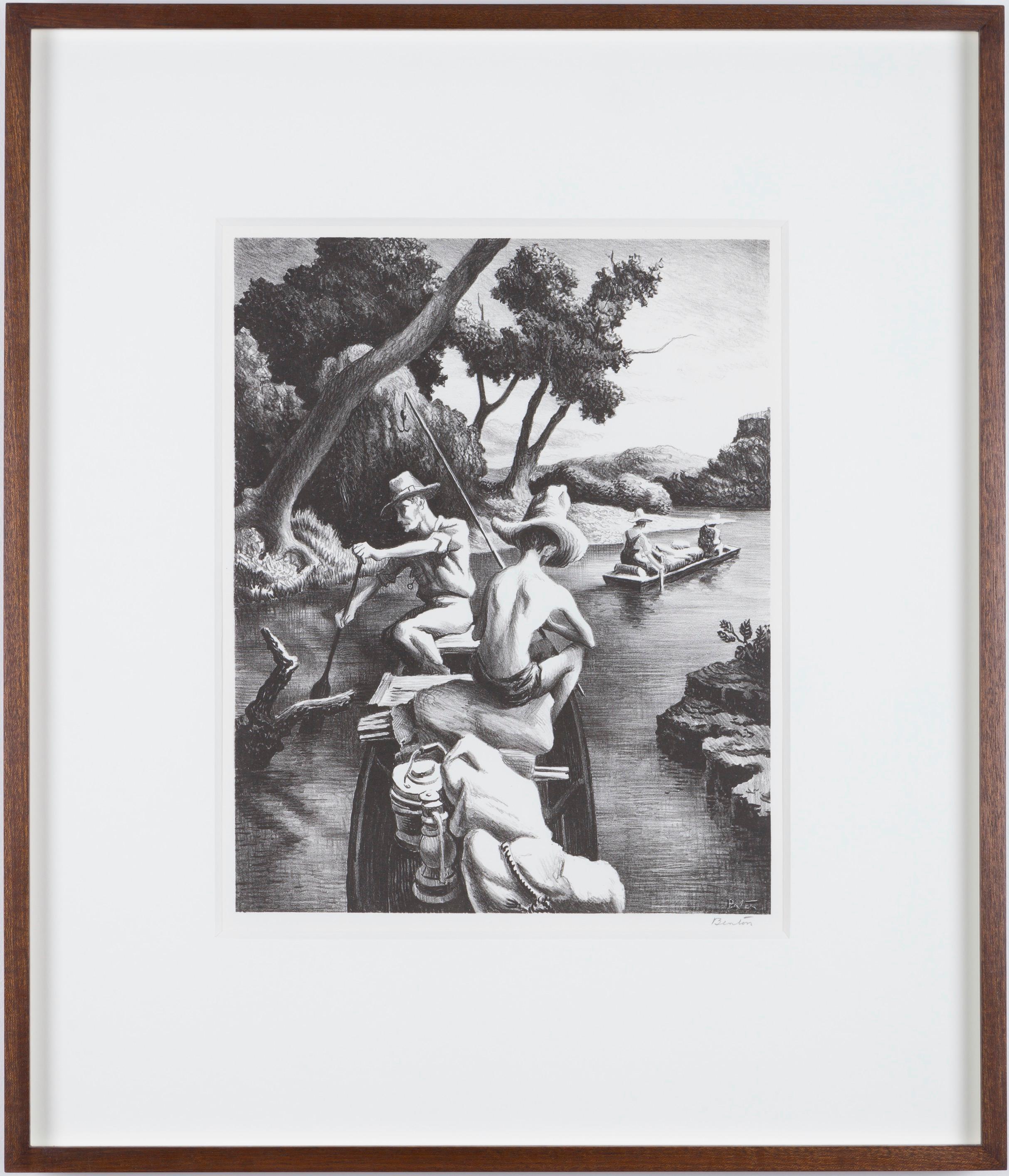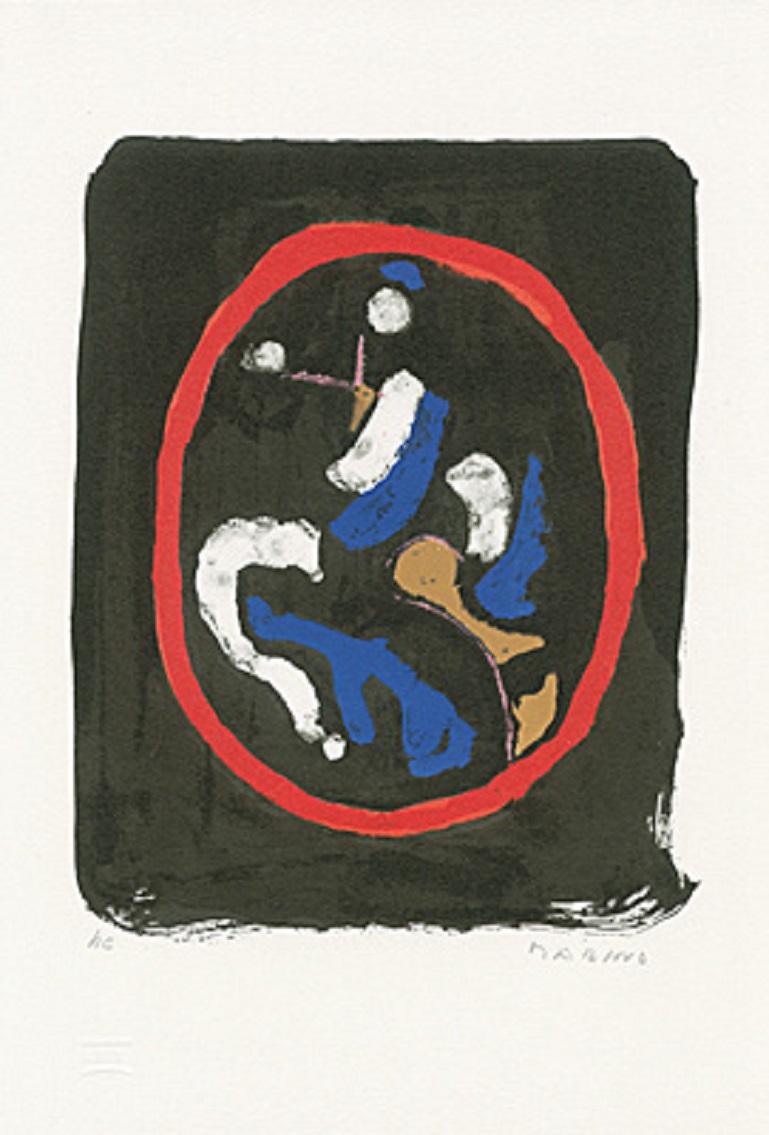Items Similar to Accordioniste's Family
Want more images or videos?
Request additional images or videos from the seller
1 of 6
(after) Fernand LégerAccordioniste's Family1950
1950
About the Item
This is a period production from the Leger Estate.
On Cream Wove Paper
Stamped "Serigraphie Leger"
Sheet Size: Approx 21 x 14 inches
Framed Size: Approx. 24 x 21 inches
One of the major Cubist painters in France in the early 20th Century, Fernand Léger, also became a sculptor, ceramist, art educator and filmmaker. He was born in Normandy where his father raised livestock, and originally studied to be a re-toucher of photographs and an architect's draughtsman. Between 1897 and 1899, he was apprenticed to an architect in Caen, and then worked in Paris for two years as a draughtsman followed by two years as a retoucher.
In 1903, he applied to the Ecole des Beaux Arts* in Paris but was denied admission, so he enrolled at the Acdemie Julian* and the Ecole des Arts Decoratifs*. He also 'hung around' the Ecole des Beaux Arts* Academy, studying with Jean Leon Gerome but saying later that the experience was "three empty and useless years".
However, he did begin to work seriously as a painter, first working in a style influenced by Impressionism*. Later he destroyed most of the work of this period. In 1907, upon seeing the painting of Cézanne at the Salon d'Automne*, he adopted a more geometrical style. By 1910, affiliated with the Puteaux Group*, an offshoot of the Cubist movement, and living among bohemian artists in Montparnasse in Paris, he had adopted his own form of Cubism*, which critics dubbed 'Tubism' because of the emphasis on cylindrical forms. Soon he was considered one of the country's three major Cubist painters along with Pablo Picasso and Georges Braque but differed from then in that he did not do collage*, and he placed curvilinear forms against rectilinear grids. In his stiriving for a sense of action in his paintings with the curvilinear lines, Léger was also much influenced by the Futurism* of Italy.
During World War I, Leger was gassed in Verdun in 1916 during service in the army, which he joined in 1914 and was at the front in Argonne. He did many sketches of wartime subjects, especially airplanes and guns and fellow soldiers, and during convalescence in Villepinte, he painted The Card Players (1917). This painting has been described as "a canvas whose robot-like monstrous figures reflect the ambivalence of his experience of war." (wikipedia) This work, reflecting his shock at the realities of war, was the beginning of his 'mechanical' period, the turning of his back on abstraction.
He devoted himself to depicting common, real objects that he described as "everyday poetic images" and that gave him a sense of returning to order. Cityscapes and machine parts became subjects in his work as did nude females, mothers and children, and animals grazing in landscapes. These paintings had very bold colors. Not everyone appreciated his work. Alfred Barr, Director of the Museum of Modern Art, said that Léger was a "noisy artist chasing fire engines, the business about him being a champion of the machine, and the clever mot about 'Tubism' ".
In 1919, Leger married Jeanne-Augustine Lohy, and the following year began a friendship with Le Corbusier, a French Swiss architect who espoused modernism and became affiliated with the International Style*.
In 1925, influenced by Le Corbusier, he did some mural decorating of highly abstract designs with Robert Delaunay for the entry hall of the exhibition Les Arts Décoratifs. He became affiliated with the Purist Movement* and the aesthetics of machines espoused by the Purists and created paintings with that "were static, precise and polished appearance of machinery." (artcult) He also did paintings with gigantic objects isolated in space, created decor for theatres, and experimenting with cinema, produced the "Ballet Mechanic", the first film that did not have a script and one much influenced by Futurism. It was a "series of images of a woman's lips and teeth, close-up shots of ordinary objects, and repeated images of human activities and machines in rhythmic movement." (wikipedia) At one point he considered giving up painting for filmmaking
Fernand Leger lived in the United States during World War II, teaching at Yale University and Mills College. He was much startled by the sight of trash or refuse in landscape, the juxtaposition of junk with flowers, and he did paintings reflecting these sights such as The Tree in the Ladder (1944) and Romantic Landscape (1946).
He returned to Paris after the war and opened an art academy with Robert Brice, a former student. He became a member of the communist party and again returned to a more realist style focused on activities of common people. Reflecting his interest in working classes and his desire to make artwork understandable to them, he did large paintings "celebrating the people, featuring acrobats, cyclists and builders, thickly contoured and painted in clear, flat colours". (artchive)
From 1946 to 1949, he created a mosaic for the facade of the church at Assy; in 1950, he founded a ceramics studio at Biot, which in 1957, became the Leger Museum; in 1951; he completed windows for the church at Ardincourt; and in 1954, he did windows for the University at Caracas.
Leger's first wife died in 1950, and two years later he married Nadia Khodossevitch.
He died at his home in 1955, and is buried in Gif-sur-Yvette, Essone.
The Musée des Arts Décoratifs in Paris hosted a memorial retrospective exhibition in 1956, and the next year one was held at the Haus der Kunst in Munich. In 1998, the Museum of Modern Art in New York City held a retrospective of the work of Fernand Léger.
- Creator:(after) Fernand Léger (1881 - 1955, French)
- Creation Year:1950
- Dimensions:Height: 25 in (63.5 cm)Width: 21 in (53.34 cm)
- Medium:
- Movement & Style:
- Period:
- Condition:
- Gallery Location:Missouri, MO
- Reference Number:1stDibs: LU74732276471
About the Seller
5.0
Vetted Seller
These experienced sellers undergo a comprehensive evaluation by our team of in-house experts.
Established in 1970
1stDibs seller since 2017
141 sales on 1stDibs
Typical response time: 21 hours
- ShippingRetrieving quote...Ships From: Missouri, MO
- Return PolicyA return for this item may be initiated within 2 days of delivery.
More From This SellerView All
- Devant le Tableau (Signed and Numbered)By Marc ChagallLocated in Missouri, MOLithograph on Arches Paper Pencil Signed Lower Right, "Marc Chagall" Numbered Lower Left Ed. 9/40, one of 40 impressions reserved for the artist aside from the standard signed editio...Category
1960s Modern Figurative Prints
MaterialsLithograph
- The Blue BicycleBy Will BarnetLocated in Missouri, MOThe Blue Bicycle, 1979 Will Barnet (American, 1911-2012) 26 x 25.5 inches 41 x 40 inches with frame Titled Lower Center Signed and Dated Lower Right Edition 41/300 Lower Left From B...Category
1970s American Modern Figurative Prints
MaterialsLithograph
- L'Offrande (Signed and Numbered)By Marc ChagallLocated in Missouri, MOLithograph on Arches Paper Pencil Signed Lower Right, "Marc Chagall" Numbered Lower Left Ed. 51/100 Published by CH. SORLIER SIte Size: 19 x 12.5 Framed Size: approx 27.5 x 22.5Category
1960s Modern Figurative Prints
MaterialsLithograph
- Personnages De Sacre Printemps VBy Marino MariniLocated in Missouri, MOColor Lithograph Signed and Numbered Ed. 75 Marino Marini (February 27, 1901 — August 6, 1980) was an Italian sculptor. Born in Pistoia, Marini is particularly famous for his serie...Category
1970s Modern Figurative Prints
MaterialsLithograph
- AngelBy Ted (Ettore) De GraziaLocated in Missouri, MO"Angel" 1979 Color Lithograph Ed. 15/70 Pencil Signed and Number Image: Approx. 25 x 20 Framed Size: 34 1/2 x 28 1/4Category
1970s Modern Figurative Prints
MaterialsLithograph
- Profil RoseBy André MassonLocated in Missouri, MOSigned Lower Right Numbered 61/200 Sight Size: 27.5 x 21.5 Framed Size: 31.5 x 24.5 Andre Masson was born in Balagne, France on January 4,1896. He was an engraver, sculptor, stage d...Category
1960s Modern Figurative Prints
MaterialsLithograph
You May Also Like
- L'inspiré Self Portrait Marc Chagall Valentina Vava Lithograph 1963 Mourlot 398By Marc ChagallLocated in Eversholt, BedfordshireInspiration or L'inspiré - The artist and his wife, self-portrait. This is a self-portrait of the great artist, depicting him as lost in thought before one of his paintings, which is apparently related to his home country Russia, as suggested by the small figure in the lower right of the work. Chagall’s wife Valentina (“Vava”), who was also from Russia, is looking over his shoulder, full of longing. The small surreal elements that are characteristic of Chagall’s paintings are also present here: the silhouettes of the houses that seems to stick out of the painting and a figure with a flute or trombone standing on its head. Chagall Lithographe, Volume II of the catalogue raisonné of Chagall's lithographic work, see Mourlot 398, 1957-1962, Paris 1963, imprinted by Imprimerie Mourlot for the publisher André Sauret. A lithographic plate from the catalog that was published in 10,000 copies. Condition : Excellent Set inside a cream mount bearing brass cartellino Visible sheet size length 23cm, Height 31.50cm In a carved and gilded frame Frame size Length 44cm, Height 55.5cm The reverse with a paper label in Japanese Provenance : Private Collection, purchased with Lovers in GreyCategory
1960s Modern Figurative Prints
MaterialsLithograph
- DiscussionBy Thomas Hart BentonLocated in London, GBA fine impression with large full margins published by Associated American Artists.Category
1930s American Modern Figurative Prints
MaterialsLithograph
- Old Man ReadingBy Thomas Hart BentonLocated in London, GBA fine impression with full margins with minor discolouration published by Associated American Artists with their information label attached.Category
1940s American Modern Figurative Prints
MaterialsLithograph
- Prodigal SonBy Thomas Hart BentonLocated in London, GBA fine impression with full margins published by Associated American Artists with their information label present - pictured in Art and Popular Religion in Evangelical America, 1815-...Category
1930s American Modern Landscape Prints
MaterialsLithograph
- Down the RiverBy Thomas Hart BentonLocated in London, GBA fine impression of this popular Benton image with good margins.Category
1930s American Modern Figurative Prints
MaterialsLithograph
- "Composizione" by Marino Marini, Black, Figurative Print, ModernBy Marino MariniLocated in Köln, DE"Compositione" by Marino Marini is part of the catalogue "Marino Marini Druckgraphik" Catalogue edited in 1976, Haus der Kunst Munich Book with 1 color ...Category
1970s Modern Figurative Prints
MaterialsLithograph
Recently Viewed
View AllMore Ways To Browse
Return To Order
Vintage Italian Family
After Corbusier
After Le Corbusier
Leger City
Mother And Children Italy
Fire Engine
Picasso Lithograph Ballet
Vintage Style Tubs
Polish Lithograph
Vintage Flower Collage
Vintage Flowers Collage
Animal Print Flats
Vintage A Frame Ladder
Nude Sketch Of A Woman
Card Players
Picasso Flower Print
Corbusier Lithograph





